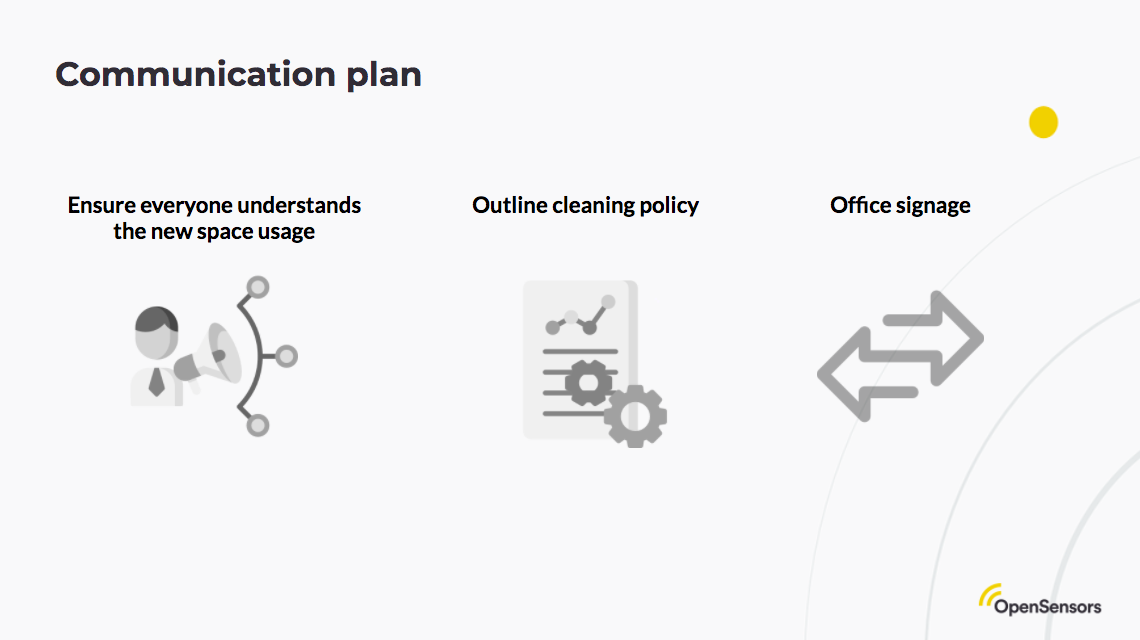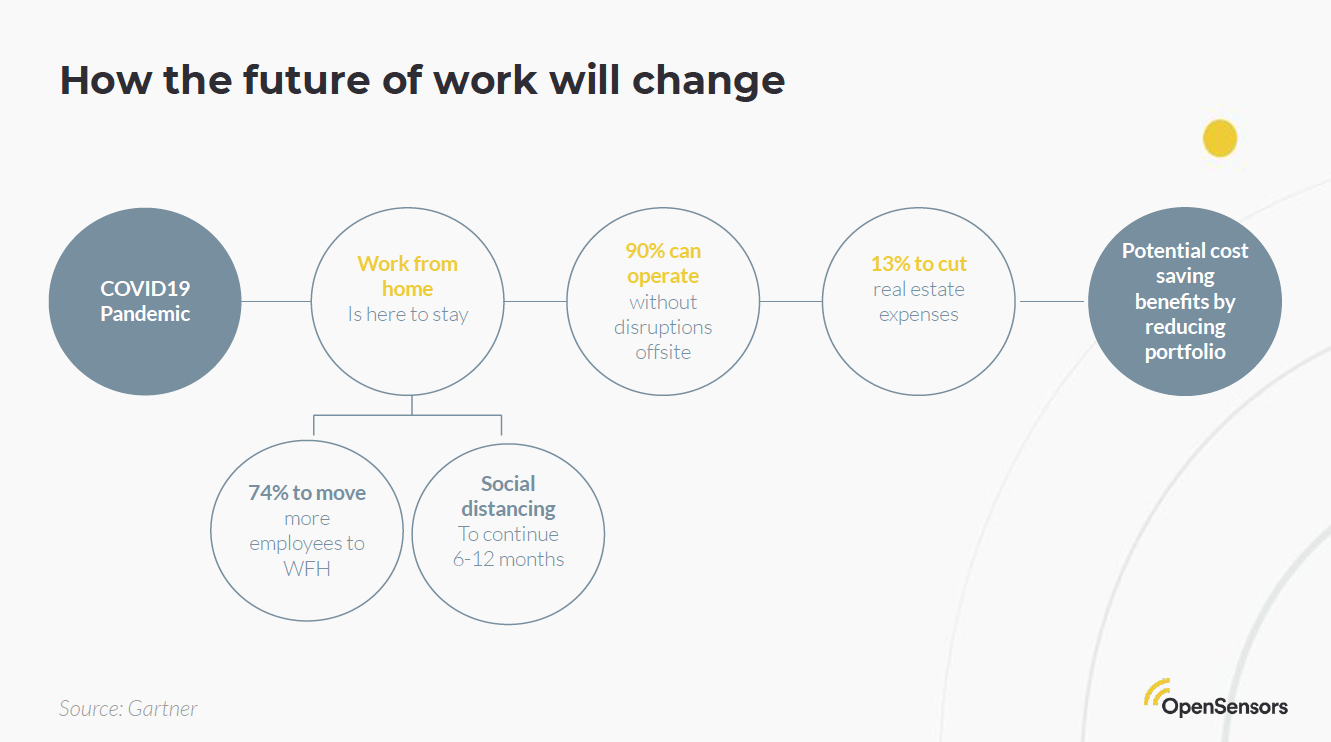With most employees currently working from home, tackling the return to the workplace could seem far ahead in time. Pre-planning a phased return will help you better manage social distancing post covid19.
What else can businesses keep in mind now for later?
- How to manage social distancing in the office
- Why prepare now for the next 6-12 months?
- Business continuity planning
By looking at these three pillars of the return to work post covid, organisations can ensure that it is well prepared in terms of the elements that can be foreseen.
How to manage social distancing in the office
The physical set up of the workplace should do the work when it comes to facilitating social distancing in the office. This is absolutely crucial when dealing with an open plan office where contact between employees could be harder to manage.
We recommend to avoid having all employees go back to the office in one go. Instead start with 20%-30% capacity and increase this over time whilst monitoring the situation. Simple steps such as those listed below can help you better organise social distancing in your office:
- Pre-plan seating arrangements with key teams and stakeholders
- Limit the number of people in each building or floor
- Set up 2-3 desk separation between individuals
- Avoid back to back seating arrangements
- Remove furniture or equipment to spread out workstations such as extra chairs or tables
- Reuse meeting rooms as workstations if necessary
- Restrict use of shared spaces such as collaborative zone, cafeterias or coffee stations
- Limit the size of group gatherings
- Schedule lunch shifts to avoid large crowds in cafeterias or canteens
- Use directional signage on floors and walls
- Identify workspaces to use as quarantine zones in cases of outbreaks
Leverage utilisation data
- Use footfall counting data on each floor to monitor the peak number of people on each floor
- Provide cleaning suppliers with daily desk and space utilisation data to ensure deep cleaning of surfaces that have been used
- Use occupancy data such as desk utilisation to manage seating arrangements and social distancing rules are followed
- Use air quality data such as CO2 levels to get an insight into whether fresh air is circulating appropriately on a floor
- Ensure humidity levels is kept between 40%-60% indicated by early research as the ideal level to contain the virus
- Use employee surveys to understand what specific challenges people are having during this extended work from home

Safeguarding the wellbeing of employees
Every organisation has the responsibility to take certain protective measures to ensure that on top of social distancing, employees returning to the office are safe to do so.
Adopting flexible working hours or staggering groups back can avoid people being in a closed space for too long. Not only will you be able to efficiently manage daily cleaning but it will have a positive impact on your employee’s well being.
Depending on the setup of your workplace or organisation, certain protective equipment should be provided to your employees:
- Disposable gloves and face masks
- Placing hand sanitisers at workstations or near high touch areas such as lifts, lobbies or restrooms
- Provide disinfectant products for employees to sanitise their workspace regularly
- Screening tests
- Disposable cutlery in cafeterias
- Use contactless payment facilities if applicable
In addition, increasing the frequency of cleaning, providing clear signage of which desks are in use or zones that are restricted will help you better facilitate social distancing.
In spaces with multiple people going in and out regularly, managing social distancing can be somewhat challenging but simple measures can be put in place to ease this. For example, using a monitoring system to alternate access to staff members with key cards. Enforcing reminders of the necessary precautions that employees ought to take should be put up in visible areas of the workplace.
Why prepare now for the next 6 - 12 months?
Preparing in advance for the year or half a year ahead will not be business as usual. In order to tackle post COVID19 obstacles, organisations should look at two key areas that will ease the management of workspaces:
- Staying on top of the situation
- Necessary modifications to the workplace
For the organisation to stay on top of the situation upon return to work, the establishment of a task force should be considered. They should be tasked with keeping track of government announcements, information released from the World Health Organisation (WHO), the NHS and or other relevant entities.
The establishment of a call tree as per the hierarchical organisational chart (or other preferred method) can facilitate the communication line and ensure that information reaches team members without overwhelming everyone.
Keeping employees updated with progress will instil a sense of safety and reinforce confidence that measures are in place to protect their well being. This will increase the likelihood of a smoother transition back to the office.
The majority of the workforce will likely continue to work from home over the coming months with some roles permanently moved to remote working. This means new ways of working and technology enablement will need to be reviewed as well as real estate management will change.
Consider what impacts these changes will have to employee productivity levels, whether changes to workspaces would be suitable in 6 months time or if more changes are likely required.
By anticipating likely changes now puts you in a better position to make informed decisions as to whether you have the resources, budget and flexibility to make more short term changes when needed.
Business continuity planning
When moving from a business as usual to an unusual working arrangement, the disruption itself will impact the business. That being said, with the current hit that organisations have taken, it’s imperative to think forward, assess and identify how to include this type of disruption as part of business continuity planning for the future.
In a recent
Gartner survey, 71% of CXOs cited business continuity and productivity are the biggest risks from covid, followed quite closely by:
- Employee health and safety (69%)
- Financial risk (45%)
- Information security risk (40%)
- Fraud risk (27%)
- IT risk (27%)
CFOs and CRE’s will naturally plan to consolidate real estate with working from home becoming the norm. Consider how you will need to manage space capacity with limited space. Much collaboration will be needed across key functions to develop your strategy and plan exit strategies (in case of an emergency).
Cleaning, security and IT costs will increase significantly and become a permanent budget line for the foreseeable future, from forecasting suppliers and equipment. Have a realistic view of what it will cost to operate in a post COVID19 era.
Want to learn more?
Whether you need help with workplace analytics, consultation on your strategy or guidance on your workplace plans, we're here to help. Call us on +44 (0)20 3868 4376 or




